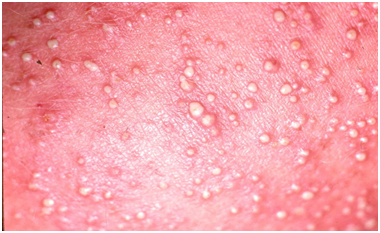Prickly Heat Causes, Symptoms, Diagnosis and Treatment

What Is Prickly Heat
Prickly heat rash, also called malaria, is the medical term for the heat related skin condition where tiny, pinpoint, pink to clear bumps form over a body area like the face or neck. It is caused when small sweat droplets are trapped in the skin due to blocked pores. This trapping of sweat may cause inflammation and itching around the sweat pores. Malaria is very common in infants but may also occur in adults. This condition occurs particularly after repeated episodes of sweating in a hot, humid environment. Malaria may look like small clear blisters or like gooseflesh.
Causes of Prickly Heat
Causes of Prickly Heat are as follows:
- Heat rash happens when the sweat gland ducts get plugged due to dead skin cells or bacteria such as Staphylococcus epidermidis, a common bacterium that occurs on the skin and is also associated with acne.
- If the bacteria get inside the plugged sweat glands, it can lead to inflammation that appears as a rash.
- Anything that causes a person to sweat more can lead to malaria. It is common in humid, tropical climates.
- Long periods of bed rest, due to immobility, and illness, can make a patient sweat, especially if using an electric blanket and other warm bedding.
- Wearing too much clothing in winter or sitting too close to a fire or heater can induce a rash.
- Certain medications make it more likely, for example, psychotropic’s, which affect mental functions or behavior and can raise the body’s temperature.
- Medications for Parkinson’s disease can inhibit perspiration, so they too, increase the risk.
- Drugs that alter the fluid balance in the body, such as tranquilizers and diuretic medications, or water pills, increase the tendency to develop prickly heat symptoms.
Symptoms of Prickly Heat
Prickly Heat begins with excessive perspiration, usually in a hot, humid environment. The perspiration makes it easier for dead skin cells and bacteria on the skin to block the sweat glands, forming a barrier and trapping sweat beneath the skin, where it builds up, causing the characteristic bumps. As the bumps burst and sweat is released, there may be a prickly or stinging sensation that gives this condition its name.
Diagnosis of Prickly Heat
The Diagnosis of Prickly Heat is made by physical examination. Knowing that the rash appears during sweating or heat, appreciating the location on the body (in skin creases or where clothes fit tightly) and seeing what the rash looks like is enough to make the diagnosis. As with many rashes, the health care professional may look at the involved skin and because of previous experience, immediately make the diagnosis.
Treatment of Prickly Heat
In most cases the rash will clear without any treatment. However, severe cases can last for several weeks. One or more of the following may help to treat prickly heat (malaria) and prevent further episodes from developing:
- If possible, avoid heat and humidity.
- Avoid further sweating.
- A cool bath or shower
- Simple creams (calamine lotion).
- Wear loose cotton clothing
- Using an antibacterial soap or antiseptic wash.
- A steroid cream.
If you feel generally unwell, you may be developing heat exhaustion or heatstroke. If this occurs, seek medical attention.
Related Articles:
Swimmers Itch Causes, Symptoms, Diagnosis and Treatment
Tularemia Causes, Symptoms, Diagnosis and treatment
Cold Sores Causes, Symptoms, Diagnosis and Treatment
Hemangioma Causes, Symptoms, Diagnosis and Treatment
Progeria Causes, Symptoms, Diagnosis and Treatment
Raynaud’s Disease Causes, Symptoms, Diagnosis and Treatment
Stye Causes, Symptoms, Diagnosis and Treatment
Antiphospholipid Syndrome (APS) Causes, Symptoms, Diagnosis And Treatment
Castleman Disease Causes, Symptoms, Diagnosis And Treatment
Diaper Rash Causes, Symptoms, Diagnosis and Treatment
Cellulitis Causes, Symptoms, Diagnosis and Treatment
Tinea Versicolor Causes, Symptoms, Diagnosis and Treatment
5 Amazing Supplement and Creams for Tinea Versicolor
By : Natural Health News




